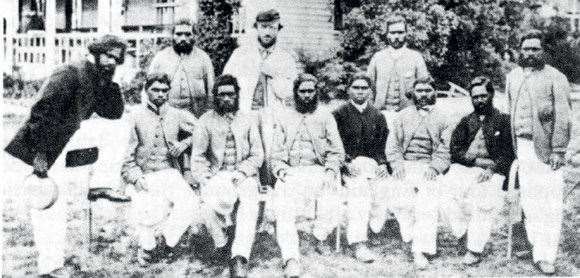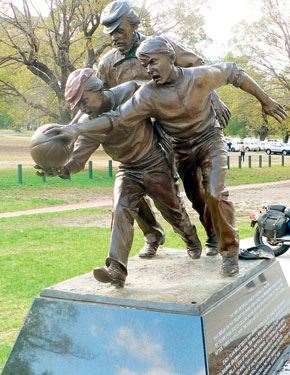A Fine Cricketer and Footballer, and the first man to write up a set of rules for our indigenous code of Football: Tom Willis is a colourful, tragic giant of Australian Sport.
A Fine Cricketer and Footballer, and the first man to write up a set of rules for our indigenous code of Football: Tom Willis is a colourful, tragic giant of Australian Sport.
 Wills with his Aboriginal team of 1866-7.
Wills with his Aboriginal team of 1866-7.Image: Getty Images
The place of Tom Wills in Australia’s folklore should be as prominent as Bradman’s, Phar Lap’s or Darcy’s, but his role in our sporting history has been “de-emphasised”, first by the Melbourne Cricket Club, who deprecated his “unwholesome” character, and then more recently by debate as to whether the ancient Aboriginal game, Marn Grook, is Australian rules’ precursor.
Without Tom Wills, the connection between the ancient, totemic game based on kicking a possum skin or typha-root “ball” (and characterised by high leaping, spectacular catching and long kicking) and Australian Rules football might never have been created. There’s virtually no other plausible link to the ancient game.This nexus has been called a “seductive myth” and discredited by some historians. Nevertheless, Wills’ role is indisputable, and there’s no denying that Australian rules, the game Wills played such an important part in inventing, lends itself to the talents of Indigenous people and has played a major part in inviting them into mainstream Australian sport.
Certainly, the structure and dynamic of Marn Grook, so different from other games played in the colonies at the time, seems to have informed Wills’ vision for the game he proposed in 1858. Although the spectacular mark didn’t become a feature of Australian rules until the 1880s, the game always allowed for the possibility.Wills was brought up in western Victoria and spent his younger days playing with children of the local Aboriginal people, the Tjapwarrung. His familiarity with their customs and language meant he had exposure to Marn Grook, a game played by the Tjapwarrung that also served as a ritual.
At 14, in 1850, Wills was sent to England’s Rugby school. His approach to his sport was influenced by the Indigenous people he associated with. He was an attacking, elusive rugby player and a prodigious kick of a ball. Going on to Cambridge, he was part of their first XI, and, as an accomplished all-rounder, was considered one of the best prospects in England. His sporting achievements continued upon his return to Australia. He represented Victoria in inter-colony cricket matches and became secretary of the MCC in 1857, despite this establishment bastion’s objection to his convict heritage. Wills’ forceful personality and powerful, physical presence made him a convincing character, often against the odds.
 A salute to that “first” match stands at the MCG.
A salute to that “first” match stands at the MCG.Image: Getty Images
Wills had already been involved as a player in several games of the sport that later came to be known as Australian rules. Though these were informal, he attempted to set up clubs and wrote a famous letter to Bell’s Life in Victoria, a sporting publication, in an effort to gain public interest. At 23, he umpired the famous match between Scotch College and Melbourne Grammar, often considered the first formalised game ever held, at Richmond Paddock (now Yarra Park).
A year later, Wills chaired a meeting to incorporate Melbourne Football Club. The 12 rules he and his cousin (and brother-in-law), H.C.A Harrison – also an excellent sportsman – devised became the Laws of Australian Rules Football. Wills’ memory of Marn Grook most likely inspired him when he declared that “we shall have a game of our own”– one that suited the drier, harder grounds of Australia.
Melbourne Football Club became the first Australian rules club, and by sheer force of will, Wills shaped the game in its early years. He pushed for the introduction of the oval-shaped ball and was even one of the early inventors of the tactic of “flooding”, which he employed as captain/coach of Geelong against Ballarat, when he stacked his backline to prevent the stronger Ballarat from scoring.Wills was a pioneering advocate for Aboriginal sportspeople. In 1866-7, he coached an Aboriginal cricket team, many of whom became part of the first Australian team to tour England in 1868.
But his love for Aboriginal people and their culture was to haunt him. In 1861 Wills and his father, Horatio, had moved to a property in Queensland, where Horatio and 19 of his party were attacked and killed by local Indigenous people. The troubled Wills returned to Melbourne, married, and led a life of alcoholism and debt. Dogged by dreams of being attacked on his property by Aborigines, he once committed himself to the Kew Lunatic Asylum. In 1880, suffering alcoholism, Wills was admitted to Royal Melbourne Hospital, but absconded, returned to his home in Heidelberg and stabbed himself to death. He was 44.
– Robert Drane
Related Articles

Feature Story: Moving the Needle

The Aussies at The Open













